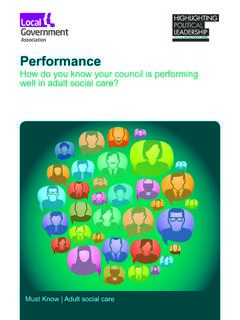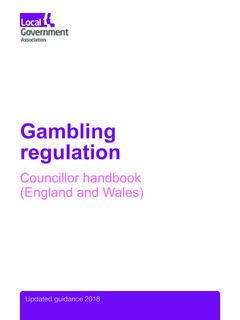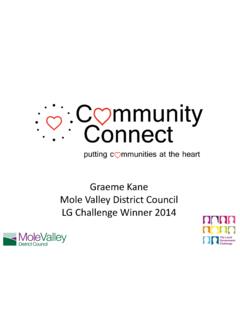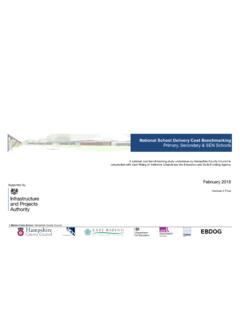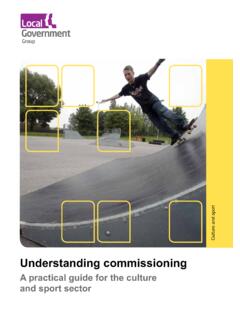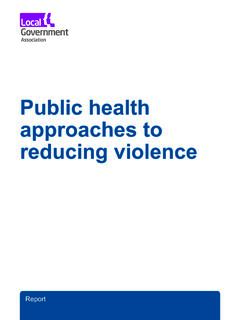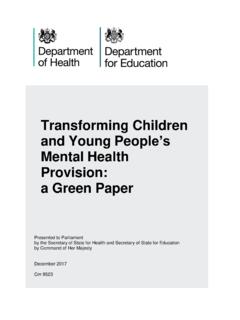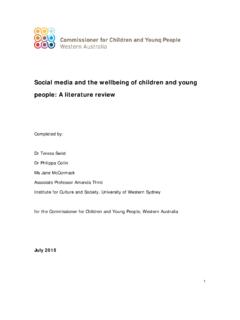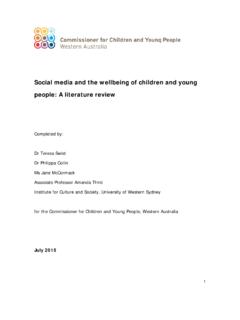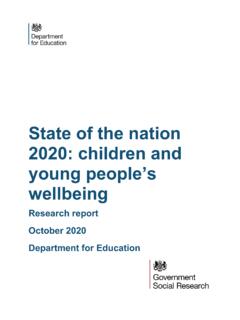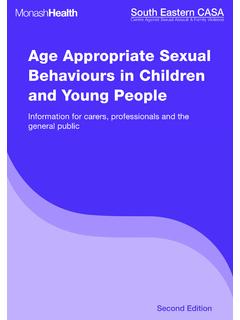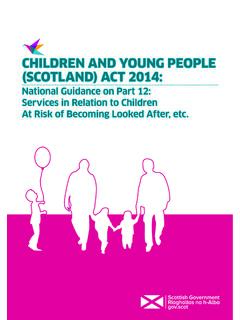Transcription of Improving children and young people’s mental health and ...
1 1 Improving children and young people s mental health and emotional wellbeingImproving children and young people s mental health and emotional wellbeingFindings from the LGA s peer learning | #gettingthebestHelping children and young people to fulfil their potential is a key ambition of all councils, but our children s services are under increasing pressure. Join our call to government for fully funded children s Improving children and young people s mental health and emotional wellbeingForewordChildhood is a very precious time.
2 It is a time for growth, development, exploration and developing the foundations for adulthood. But we know all these important elements can be damaged by the development of a mental health disorder or poor mental health as a child or young person. At this vital time of life, it is imperative that services work together to make sure children are getting the best not just getting peer learning programme has provided a fantastic opportunity for councils to share good practice and seek new solutions to local issues. We d like to thank all the councils for taking part and for sharing their thinking and learning experience, so that other councils, and ultimately children , can also benefit.
3 We know that early help in mental health can prevent symptoms escalating and give children the tools to cope with and manage their condition. More early help, and more general help for mental wellbeing, can reduce the pressure on acute care so that it has the capacity to help the most vulnerable. The learning from the programme to recognise the range of issues affecting a child s mental health , rather than focusing on a mental health disorder and treatment, resonates with councils public health approaches. Engaging the wider children s workforce to support the mental health of all children and young people .
4 We were pleased that the peer learning recognised the important role of local councillors in championing children s health and wellbeing. The Local Government Association (LGA) has been a supporter of the mental health Champions Network and we hope that councillors across the country continue to advocate on behalf of their children s mental hope that the experiences of the councils that took part in their peer learning programme will help other councils looking at the support they give to children and young people facing issues with their mental Anntionette Bramble Chair of the LGA children and young people BoardCouncillor Ian Hudspeth Chair of the LGA Community Wellbeing Board4 Improving
5 children and young people s mental health and emotional wellbeingIntroduction 5 Background 7 The LGA peer learning programme 9 What we learnt 12 Taking a holistic view of children and young people 12 Hearing young people s voices, and that of their parents 15 Developing mental health confidence and capability in the wider children s workforce 18 Strengthening the role of local councillors in championing children s emotional health and wellbeing 22 Delivering services in times of organisational change, external change and resource pressure 23 Conclusions 26 Appendix.
6 The Thrive Approach 29 Contents5 Improving children and young people s mental health and emotional wellbeingIntroductionGood mental health is just important as physical health . Having good mental wellbeing does not mean that you don t ever suffer from setbacks and difficult emotions, but that you have the resilience to cope, which in turn helps children become thriving, happier adults. The consequences of not tackling problems can be lifelong. According to NHS Digital s 2018 National children s mental health Prevalence data: one in eight children and young people have one or more mental health disorders emotional disorders have become more common, whilst all other types of disorder, such as behavioural, hyperactivity and other less common disorders, have remained similar in prevalence since 199 a quarter of girls aged 17 to 19 have a mental health disorder, and of this quarter, over half has self-harmed or attempted to take their own sources of data show that.
7 Less than a third of the 338,000 children referred to child and adolescent mental health services (CAMHS) last year received treatment within the year. Another 37 per cent were not accepted into treatment or discharged after an assessment, and a further 32 per cent were on waiting lists at the end of the 1 children s Commissioner (2018) children s mental health briefing 11 per cent of young people aged 10 to 17 report low subjective wellbeing which equates to approximately 550,000 children in In 2016, the NHS estimated that it supported 25 per cent of children and young people with a mental health condition.
8 The aspiration is to reach 35 per cent by 2020 The average waiting time in 2016 from being referred to local NHS CAMHS to beginning treatment was 94 More than 75 per cent of adults who access mental health services had a diagnosable disorder prior to the age of Self-harm among girls aged 13-16 increased by 68 per cent between 2011 and 2014, rising from to 77 per 10, Between 2010 and 2017, the number of girls aged under 19 admitted to hospital for anorexia increased from 1,050 to 2, Whilst girls are more likely to have depression, eating disorders, or self-harm, boys aged 15-19 remain twice as likely to commit The children s Society (2018) The Good Childhood Report 2018.
9 London: The children s Society3 NHS (2016) Implementing the Five Year Forward View. Redditch: NHS England [last accessed 23 August 2018]4 The children s Society (2017) Stick with us. [last accessed 23 August 2018]5 The children s Society (2016) Priorities for Improving children s mental health services. [last accessed 23 August 2018]6 NHS (2017) Worrying rise in reports of self-harm among teenage girls in UK [last accessed 23 August 2018] 7 Sarah Marsh (2018) Eating disorders: NHS reports surge in hospital admissions. London: The Guardian.
10 [last accessed 23 August 2018]8 Brittany Bokzam (2017) mental health data shows stark difference between girls and boys London: The Guardian. [last accessed 23 August 2018]6 Improving children and young people s mental health and emotional wellbeingOur children and young people s mental health and Emotional Wellbeing Peer Learning Programme was designed to look at how to prioritise early help and free up acute care for the most vulnerable in order to achieve change; supporting councils and their local partners to learn from each other, and from other councils across the giving eight councils and their partners an opportunity to take part in two learning days and a visit to another council, the hope is that they now have the knowledge to tackle their local issue so that more children and young people can get the help they need.
